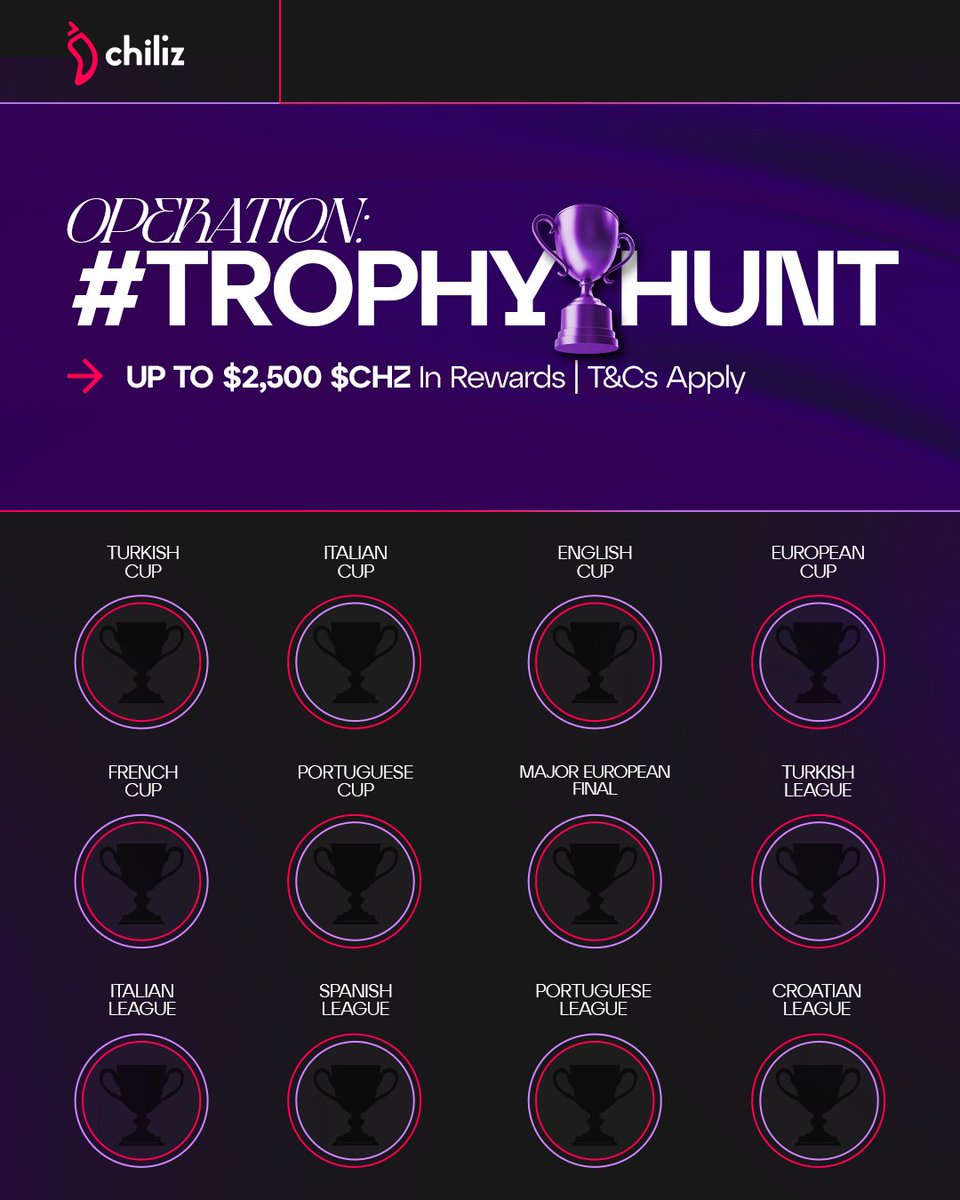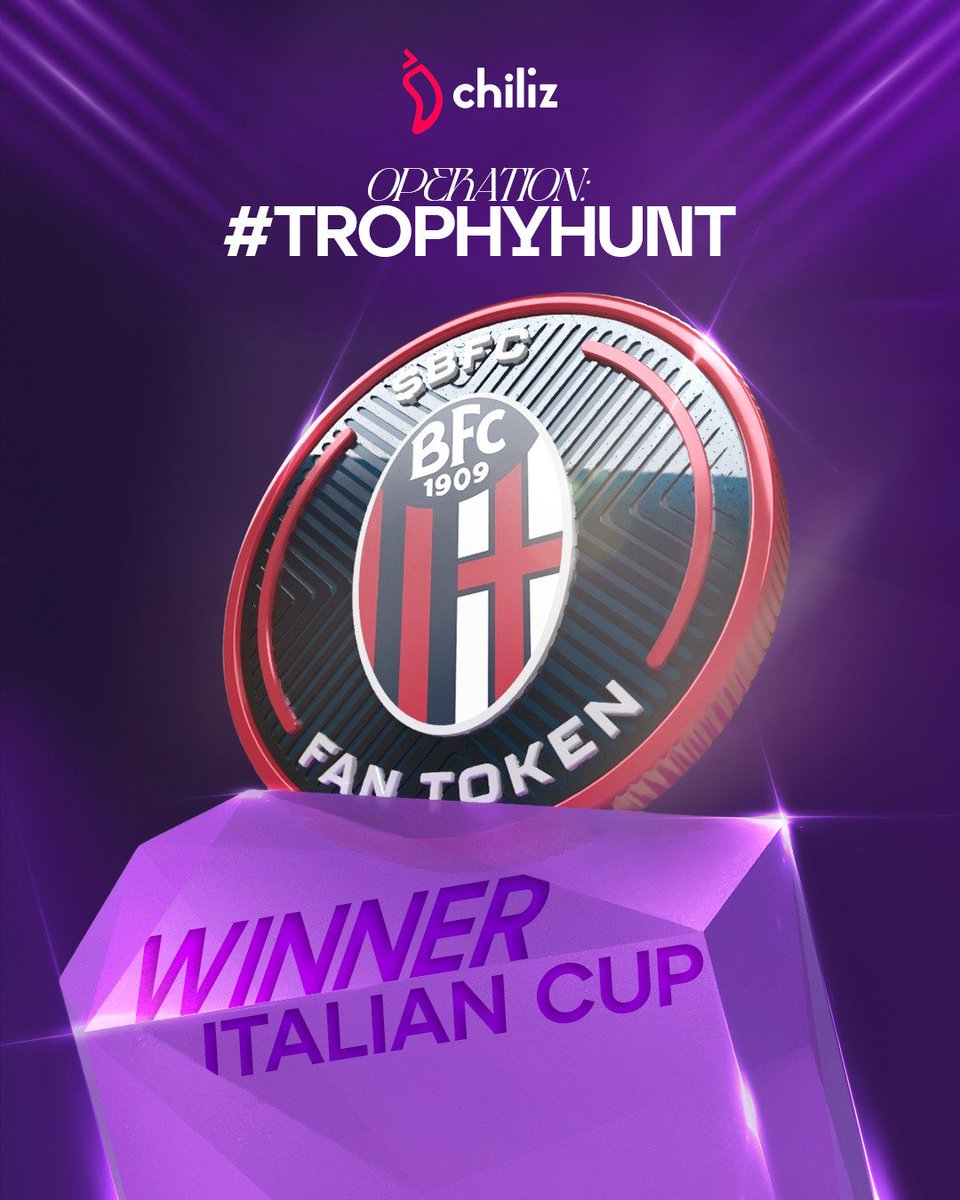
CHZ
Chiliz-pris
$0,045020
-$0,00330
(−6,83 %)
Prisförändring de senaste 24 timmarna

Hur känner du för CHZ idag?
Dela dina känslor här genom att göra tummen upp om du känner dig bullish för coin eller tummen ner om du känner dig bearish.
Rösta för att visa resultat
Friskrivningsklausul
Det sociala innehållet på den här sidan ("Innehållet"), inklusive men inte begränsat till tweets och statistik som tillhandahålls av LunarCrush, kommer från tredje part och tillhandahålls " i befintligt skick" och endast i informationssyfte. OKX garanterar inte innehållets kvalitet eller sanningshalt, och innehållet representerar inte OKX:s åsikter. Det är inte avsett att tillhandahålla (i) investeringsrådgivning eller -rekommendationer; (ii) ett erbjudande eller en uppmaning att köpa, sälja eller inneha digitala tillgångar; eller (iii) finansiell, redovisnings-, juridisk eller skatterådgivning. Digitala tillgångar, inklusive stabil kryptovaluta och NFT:er, innebär en hög grad av risk och kan fluktuera kraftigt. Priset och prestandan för den digitala tillgången är inte garanterade och kan ändras utan föregående meddelande.<br>OKX tillhandahåller inga rekommendationer om investeringar eller tillgångar. Du bör noga överväga om handel eller innehav av digitala tillgångar är lämpligt för dig, med tanke på din ekonomiska situation. Vänligen rådfråga en juridisk-/skatte-/investeringsrådgivare för frågor om just dina specifika omständigheter. För mer information, vänligen se våra <a href="/help/terms-of-service">Användarvillkor</a> och <a href="/help/risk-compliance-disclosure">Riskvarning</a>. Genom att använda tredjepartswebbplatsen (”third-party website/TPW”) godkänner du att all användning av TPW kommer att omfattas av och regleras av villkoren i TPW. Om inte annat uttryckligen anges skriftligen är OKX och dess dotterbolag ( OKX ) inte på något sätt associerade med ägaren eller operatören av TPW. Du samtycker till att OKX inte är ansvarigt eller skyldigt för någon förlust, skada eller andra konsekvenser som uppstår på grund av din användning av TPW. Vänligen observera om att användning av en TPW kan resultera i förlust eller minskning av dina tillgångar. Produkten kanske inte är tillgänglig i alla jurisdiktioner.
Chiliz marknadsinfo
Marknadsvärde
Marknadsvärde beräknas genom att multiplicera det cirkulerande utbudet av ett coin med dess senaste pris.
Börsvärde = Cirkulerande utbud × Senaste pris
Börsvärde = Cirkulerande utbud × Senaste pris
Cirkulerande utbud
Totalt belopp för ett coin som är allmänt tillgängligt på marknaden.
Marknadsvärde-rankning
Ett coins rankning i termer av marknadsvärde.
Högsta någonsin
Högsta pris ett coin har nått i sin handelshistorik.
Lägsta någonsin
Lägsta pris ett coin har nått i sin handelshistorik.
Marknadsvärde
$431,79M
Cirkulerande utbud
9 595 343 456 CHZ
100,00 % av
9 595 343 456 CHZ
Marknadsvärde-rankning
--
Granskningar

Senaste granskningen: 18 okt. 2023
Högsta priset under 24 tim
$0,048420
Lägsta priset under 24 tim
$0,044670
Högsta någonsin
$0,94489
−95,24 % (-$0,89987)
Senast uppdaterad: 13 mars 2021
Lägsta någonsin
$0,034440
+30,72 % (+$0,010580)
Senast uppdaterad: 9 apr. 2025
Chiliz-flödet
Följande innehåll är hämtat från .

Chiliz - The Sports Blockchain
Operation #TrophyHunt: Uppdrag #2
Bara en kan lyfta den italienska cupen - $ACM eller $BFC. 🏆
Vem väljer du?
Idag, kl. 21:00 CEST.


Chiliz - The Sports Blockchain
12 möjligheter. 12 troféer att lyfta.
$CHZ till ett värde av upp till $2 500 finns att vinna.
Det här är Operation: #TrophyHunt 🏆
Låt oss samla dem alla.

9,61 tn
42

Chiliz - The Sports Blockchain
Från att driva Dojo ⛩️ till att förena en snabbt växande global fanbase. @NIP:s Web3-resa med @Chiliz handlar om att höja fansens anslutning. 🔥
"Vår fanbase fortsätter att växa. @Socios hjälper oss att föra ninjorna samman på ett sätt som utvecklas med dem." - Hicham Chahine, VD för NIP.
Visa original
18,77 tn
85

BeInCrypto
SportFi: Teknisk och grundläggande analys av ekosystemet för @chiliz och Token
År 2019 använde Juventus-fansen $JUV Tokens för att rösta på klubbens mållåt, vilket sparkade igång SportFi! 🚀
Nu driver Chiliz ($CHZ) 70+ Token-klubbar som PSG, Barca och Man City. Med ett marknadsvärde på bara 370 miljoner dollar, är det kryptos nästa genombrott? Utforska analysen!
Läs mer 🔗
Visa original
16,45 tn
40
CHZ-kalkylator


Chiliz prisutveckling i USD
Aktuellt pris på Chiliz är $0,045020. Under de senaste 24 timmarna har Chiliz minskade med −6,83 %. Det har för närvarande ett cirkulerande utbud av 9 595 343 456 CHZ och ett maximalt utbud av 9 595 343 456 CHZ, vilket ger ett marknadsvärde efter full utspädning på $431,79M. För tillfället innehar Chiliz-coin position 0 i marknadsvärdesrankningar. Chiliz/USD-priset uppdateras i realtid.
Idag
-$0,00330
−6,83 %
7 dagar
+$0,0031600
+7,54 %
30 dagar
+$0,0082000
+22,27 %
3 månader
-$0,01670
−27,06 %
Populära Chiliz-omvandlingar
Senast uppdaterad: 2025-05-15 21:57
| 1 CHZ till USD | 0,045000 $ |
| 1 CHZ till EUR | 0,040177 € |
| 1 CHZ till PHP | 2,5092 ₱ |
| 1 CHZ till IDR | 743,68 Rp |
| 1 CHZ till GBP | 0,033858 £ |
| 1 CHZ till CAD | 0,062938 $ |
| 1 CHZ till AED | 0,16529 AED |
| 1 CHZ till VND | 1 167,01 ₫ |
Om Chiliz (CHZ)
Betyget som anges är ett sammanställt betyg som inhämtats av OKX från källorna som anges, och det anges endast för informativa syften. OKX garanterar inte betygens kvalitet eller korrekthet. Det är inte avsett att utgöra (i) investeringsrådgivning eller rekommendation, (ii) ett erbjudande eller en uppmaning att köpa, sälja eller inneha digitala tillgångar, eller (iii) finansiell, redovisningsmässig, juridisk eller skattemässig rådgivning. Digitala tillgångar, inklusive stabil kryptovaluta och NFT:er, omfattas av hög risk, kan skifta kraftigt och till och med bli värdelösa. Priset och prestanda för de digitala tillgångarna garanteras inte, och de kan förändras utan föregående meddelande. Dina digitala tillgångar täcks inte av försäkran mot potentiella förluster. Historisk avkastning är ingen garanti om framtida avkastning. OKX garanterar inte någon avkastning, återbetalning av huvudbelopp eller ränta. OKX tillhandahåller inga rekommendationer om investeringar eller tillgångar. Du bör noga överväga om handel med eller innehav av digitala tillgångar är lämpligt för dig med hänsyn till din ekonomiska situation. Rådgör med din jurist, skatteexpert eller investeringsrådgivare om du har frågor om dina specifika omständigheter.
Visa mer
- Officiell webbplats
- Vitbok
- Block explorer
Om tredjeparts webbplatser
Om tredjeparts webbplatser
Genom att använda tredjepartswebbplatsen (”TPW”) samtycker du till att all användning av TPW kommer att omfattas av och styras av villkoren i TPW. Om inte annat uttryckligen anges skriftligen är OKX och dess affiliates (”OKX”) inte på något sätt associerade med ägaren eller operatören av TPW. Du samtycker till att OKX inte är ansvarigt eller skadeståndsskyldigt för förlust, skada eller andra konsekvenser som uppstår till följd av din användning av TPW. Var medveten om att användning av en TPW kan leda till förlust eller minskning av dina tillgångar.
Vanliga frågor för Chiliz
Hur mycket är 1 Chiliz värd idag?
För närvarande är en Chiliz värd $0,045020. För svar och insikt om prisåtgärder för Chiliz är du på rätt plats. Utforska de senaste diagrammen för Chiliz och handla ansvarsfullt med OKX.
Vad är kryptovalutor?
Kryptovalutor, till exempel Chiliz, är digitala tillgångar som fungerar på en offentlig reskontra som kallas blockkedjor. Läs mer om coins och tokens som erbjuds på OKX och deras olika attribut, som inkluderar live-priser och realtidsdiagram.
När uppfanns kryptovalutor?
Tack vare finanskrisen 2008 ökade intresset för decentraliserad finansiering. Bitcoin erbjöd en ny lösning genom att vara en säker digital tillgång på ett decentraliserat nätverk. Sedan dess har många andra tokens som t.ex. Chiliz skapats också.
Kommer priset på Chiliz gå upp idag?
Se vår Chiliz prisprognossida för att förutse framtida priser och fastställa dina prismål.
ESG-upplysning
ESG-regleringar (Environmental, Social och Governance) för kryptotillgångar syftar till att ta itu med eventuell miljöpåverkan (t.ex. energiintensiv mining), främja transparens och säkerställa etiska förvaltningsmetoder för att anpassa kryptoindustrin till bredare hållbarhets- och samhälleliga mål. Dessa regleringar uppmuntrar efterlevnad av standarder som minskar risker och främjar förtroende för digitala tillgångar.
Tillgångsdetaljer
Namn
OKcoin Europe LTD
Relevant juridisk enhetsidentifierare
54930069NLWEIGLHXU42
Namn på kryptotillgången
Chiliz
Konsensusmekanism
Chiliz is present on the following networks: binance_beacon_chain, chiliz, chiliz_2, ethereum, solana.
Binance Beacon Chain operated on a Delegated Proof of Stake (DPoS) consensus mechanism before its operations were discontinued in fall 2024 and its migration to Binance Smart Chain; validators were elected by token holders through staking and voting, limiting active participation to a manageable number of nodes while maintaining decentralization; validators were selected based on the staking weight of their delegators, ensuring stakeholder interests were proportionally represented in the validation process; regular validator rotation was implemented to promote fairness and decentralization by allowing multiple participants to contribute to the network; the system was designed to tolerate some degree of validator failures while maintaining the network’s operational integrity, ensuring resilience.
The Chiliz Chain operates on a Proof of Staked Authority (PoSA) consensus model, a hybrid that combines Proof of Stake (PoS) and Proof of Authority (PoA) to secure the network through both economic and reputational incentives. Core Components: Proof of Staked Authority (PoSA) Validator Selection: Validators are selected based on their stake of CHZ tokens and their reputation within the network, enhancing security and trustworthiness. Collateral Requirement: Validators must lock a portion of CHZ as collateral, which can be slashed if they act maliciously or fail to meet network standards, ensuring alignment with network security.
The Ethereum network uses a Proof-of-Stake Consensus Mechanism to validate new transactions on the blockchain. Core Components 1. Validators: Validators are responsible for proposing and validating new blocks. To become a validator, a user must deposit (stake) 32 ETH into a smart contract. This stake acts as collateral and can be slashed if the validator behaves dishonestly. 2. Beacon Chain: The Beacon Chain is the backbone of Ethereum 2.0. It coordinates the network of validators and manages the consensus protocol. It is responsible for creating new blocks, organizing validators into committees, and implementing the finality of blocks. Consensus Process 1. Block Proposal: Validators are chosen randomly to propose new blocks. This selection is based on a weighted random function (WRF), where the weight is determined by the amount of ETH staked. 2. Attestation: Validators not proposing a block participate in attestation. They attest to the validity of the proposed block by voting for it. Attestations are then aggregated to form a single proof of the block’s validity. 3. Committees: Validators are organized into committees to streamline the validation process. Each committee is responsible for validating blocks within a specific shard or the Beacon Chain itself. This ensures decentralization and security, as a smaller group of validators can quickly reach consensus. 4. Finality: Ethereum 2.0 uses a mechanism called Casper FFG (Friendly Finality Gadget) to achieve finality. Finality means that a block and its transactions are considered irreversible and confirmed. Validators vote on the finality of blocks, and once a supermajority is reached, the block is finalized. 5. Incentives and Penalties: Validators earn rewards for participating in the network, including proposing blocks and attesting to their validity. Conversely, validators can be penalized (slashed) for malicious behavior, such as double-signing or being offline for extended periods. This ensures honest participation and network security.
Solana uses a unique combination of Proof of History (PoH) and Proof of Stake (PoS) to achieve high throughput, low latency, and robust security. Here’s a detailed explanation of how these mechanisms work: Core Concepts 1. Proof of History (PoH): Time-Stamped Transactions: PoH is a cryptographic technique that timestamps transactions, creating a historical record that proves that an event has occurred at a specific moment in time. Verifiable Delay Function: PoH uses a Verifiable Delay Function (VDF) to generate a unique hash that includes the transaction and the time it was processed. This sequence of hashes provides a verifiable order of events, enabling the network to efficiently agree on the sequence of transactions. 2. Proof of Stake (PoS): Validator Selection: Validators are chosen to produce new blocks based on the number of SOL tokens they have staked. The more tokens staked, the higher the chance of being selected to validate transactions and produce new blocks. Delegation: Token holders can delegate their SOL tokens to validators, earning rewards proportional to their stake while enhancing the network's security. Consensus Process 1. Transaction Validation: Transactions are broadcast to the network and collected by validators. Each transaction is validated to ensure it meets the network’s criteria, such as having correct signatures and sufficient funds. 2. PoH Sequence Generation: A validator generates a sequence of hashes using PoH, each containing a timestamp and the previous hash. This process creates a historical record of transactions, establishing a cryptographic clock for the network. 3. Block Production: The network uses PoS to select a leader validator based on their stake. The leader is responsible for bundling the validated transactions into a block. The leader validator uses the PoH sequence to order transactions within the block, ensuring that all transactions are processed in the correct order. 4. Consensus and Finalization: Other validators verify the block produced by the leader validator. They check the correctness of the PoH sequence and validate the transactions within the block. Once the block is verified, it is added to the blockchain. Validators sign off on the block, and it is considered finalized. Security and Economic Incentives 1. Incentives for Validators: Block Rewards: Validators earn rewards for producing and validating blocks. These rewards are distributed in SOL tokens and are proportional to the validator’s stake and performance. Transaction Fees: Validators also earn transaction fees from the transactions included in the blocks they produce. These fees provide an additional incentive for validators to process transactions efficiently. 2. Security: Staking: Validators must stake SOL tokens to participate in the consensus process. This staking acts as collateral, incentivizing validators to act honestly. If a validator behaves maliciously or fails to perform, they risk losing their staked tokens. Delegated Staking: Token holders can delegate their SOL tokens to validators, enhancing network security and decentralization. Delegators share in the rewards and are incentivized to choose reliable validators. 3. Economic Penalties: Slashing: Validators can be penalized for malicious behavior, such as double-signing or producing invalid blocks. This penalty, known as slashing, results in the loss of a portion of the staked tokens, discouraging dishonest actions.
Incitamentmekanismer och tillämpliga avgifter
Chiliz is present on the following networks: binance_beacon_chain, chiliz, chiliz_2, ethereum, solana.
The Binance Beacon Chain incentivized validators and ensured fee transparency before its migration to Binance Smart Chain; validators were rewarded solely through transaction fees, with no block rewards provided, aligning incentives with network usage and transaction volume; transaction fees were calculated and displayed upfront, ensuring clarity for users and promoting trust in the fee structure; a portion of transaction fees collected in BNB was burned, reducing the overall token supply and contributing to a deflationary economic model.
Chiliz incentivizes validators and delegators to contribute to network security through rewards and transaction fees in CHZ. Incentive Mechanisms: Staking Rewards Validator Rewards: Validators earn CHZ tokens for validating transactions and maintaining network integrity. Delegator Rewards: CHZ holders who delegate their tokens to validators share in staking rewards, allowing passive participation in network security. Applicable Fees: Transaction Fees CHZ-Based Fees: Transaction fees are paid in CHZ and are distributed to validators as additional compensation, supporting validator incentives and covering network operational costs.
Ethereum, particularly after transitioning to Ethereum 2.0 (Eth2), employs a Proof-of-Stake (PoS) consensus mechanism to secure its network. The incentives for validators and the fee structures play crucial roles in maintaining the security and efficiency of the blockchain. Incentive Mechanisms 1. Staking Rewards: Validator Rewards: Validators are essential to the PoS mechanism. They are responsible for proposing and validating new blocks. To participate, they must stake a minimum of 32 ETH. In return, they earn rewards for their contributions, which are paid out in ETH. These rewards are a combination of newly minted ETH and transaction fees from the blocks they validate. Reward Rate: The reward rate for validators is dynamic and depends on the total amount of ETH staked in the network. The more ETH staked, the lower the individual reward rate, and vice versa. This is designed to balance the network's security and the incentive to participate. 2. Transaction Fees: Base Fee: After the implementation of Ethereum Improvement Proposal (EIP) 1559, the transaction fee model changed to include a base fee that is burned (i.e., removed from circulation). This base fee adjusts dynamically based on network demand, aiming to stabilize transaction fees and reduce volatility. Priority Fee (Tip): Users can also include a priority fee (tip) to incentivize validators to include their transactions more quickly. This fee goes directly to the validators, providing them with an additional incentive to process transactions efficiently. 3. Penalties for Malicious Behavior: Slashing: Validators face penalties (slashing) if they engage in malicious behavior, such as double-signing or validating incorrect information. Slashing results in the loss of a portion of their staked ETH, discouraging bad actors and ensuring that validators act in the network's best interest. Inactivity Penalties: Validators also face penalties for prolonged inactivity. This ensures that validators remain active and engaged in maintaining the network's security and operation. Fees Applicable on the Ethereum Blockchain 1. Gas Fees: Calculation: Gas fees are calculated based on the computational complexity of transactions and smart contract executions. Each operation on the Ethereum Virtual Machine (EVM) has an associated gas cost. Dynamic Adjustment: The base fee introduced by EIP-1559 dynamically adjusts according to network congestion. When demand for block space is high, the base fee increases, and when demand is low, it decreases. 2. Smart Contract Fees: Deployment and Interaction: Deploying a smart contract on Ethereum involves paying gas fees proportional to the contract's complexity and size. Interacting with deployed smart contracts (e.g., executing functions, transferring tokens) also incurs gas fees. Optimizations: Developers are incentivized to optimize their smart contracts to minimize gas usage, making transactions more cost-effective for users. 3. Asset Transfer Fees: Token Transfers: Transferring ERC-20 or other token standards involves gas fees. These fees vary based on the token's contract implementation and the current network demand.
Solana uses a combination of Proof of History (PoH) and Proof of Stake (PoS) to secure its network and validate transactions. Here’s a detailed explanation of the incentive mechanisms and applicable fees: Incentive Mechanisms 4. Validators: Staking Rewards: Validators are chosen based on the number of SOL tokens they have staked. They earn rewards for producing and validating blocks, which are distributed in SOL. The more tokens staked, the higher the chances of being selected to validate transactions and produce new blocks. Transaction Fees: Validators earn a portion of the transaction fees paid by users for the transactions they include in the blocks. This provides an additional financial incentive for validators to process transactions efficiently and maintain the network's integrity. 5. Delegators: Delegated Staking: Token holders who do not wish to run a validator node can delegate their SOL tokens to a validator. In return, delegators share in the rewards earned by the validators. This encourages widespread participation in securing the network and ensures decentralization. 6. Economic Security: Slashing: Validators can be penalized for malicious behavior, such as producing invalid blocks or being frequently offline. This penalty, known as slashing, involves the loss of a portion of their staked tokens. Slashing deters dishonest actions and ensures that validators act in the best interest of the network. Opportunity Cost: By staking SOL tokens, validators and delegators lock up their tokens, which could otherwise be used or sold. This opportunity cost incentivizes participants to act honestly to earn rewards and avoid penalties. Fees Applicable on the Solana Blockchain 7. Transaction Fees: Low and Predictable Fees: Solana is designed to handle a high throughput of transactions, which helps keep fees low and predictable. The average transaction fee on Solana is significantly lower compared to other blockchains like Ethereum. Fee Structure: Fees are paid in SOL and are used to compensate validators for the resources they expend to process transactions. This includes computational power and network bandwidth. 8. Rent Fees: State Storage: Solana charges rent fees for storing data on the blockchain. These fees are designed to discourage inefficient use of state storage and encourage developers to clean up unused state. Rent fees help maintain the efficiency and performance of the network. 9. Smart Contract Fees: Execution Costs: Similar to transaction fees, fees for deploying and interacting with smart contracts on Solana are based on the computational resources required. This ensures that users are charged proportionally for the resources they consume.
Början av den period som upplysningen avser
2024-04-20
Slutet av den period som upplysningen avser
2025-04-20
Energirapport
Energiförbrukning
23708.89815 (kWh/a)
Energiförbrukningskällor och -metoder
The energy consumption of this asset is aggregated across multiple components:
For the calculation of energy consumptions, the so called “bottom-up” approach is being used. The nodes are considered to be the central factor for the energy consumption of the network. These assumptions are made on the basis of empirical findings through the use of public information sites, open-source crawlers and crawlers developed in-house. The main determinants for estimating the hardware used within the network are the requirements for operating the client software. The energy consumption of the hardware devices was measured in certified test laboratories. When calculating the energy consumption, we used - if available - the Functionally Fungible Group Digital Token Identifier (FFG DTI) to determine all implementations of the asset of question in scope and we update the mappings regulary, based on data of the Digital Token Identifier Foundation.
For the calculation of energy consumptions, the so called “bottom-up” approach is being used. The nodes are considered to be the central factor for the energy consumption of the network. These assumptions are made on the basis of empirical findings through the use of public information sites, open-source crawlers and crawlers developed in-house. The main determinants for estimating the hardware used within the network are the requirements for operating the client software. The energy consumption of the hardware devices was measured in certified test laboratories. When calculating the energy consumption, we used - if available - the Functionally Fungible Group Digital Token Identifier (FFG DTI) to determine all implementations of the asset of question in scope and we update the mappings regulary, based on data of the Digital Token Identifier Foundation.
To determine the energy consumption of a token, the energy consumption of the network(s) binance_beacon_chain, ethereum, solana is calculated first. Based on the crypto asset's gas consumption per network, the share of the total consumption of the respective network that is assigned to this asset is defined. When calculating the energy consumption, we used - if available - the Functionally Fungible Group Digital Token Identifier (FFG DTI) to determine all implementations of the asset of question in scope and we update the mappings regulary, based on data of the Digital Token Identifier Foundation.
CHZ-kalkylator
















Sociala medier